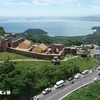 Lying on Phuong Hoang (Phoenix) Mountain and facing the Cau River, Bo Da, also known as Duc La, Pagoda in Viet Yen district is among the most major centre of Truc Lam Zen Buddhism (Photo: Vietnam+)
Lying on Phuong Hoang (Phoenix) Mountain and facing the Cau River, Bo Da, also known as Duc La, Pagoda in Viet Yen district is among the most major centre of Truc Lam Zen Buddhism (Photo: Vietnam+)  The pagoda was built in the 11th century, under the Ly dynasty but badly damaged during wars in subsequent centuries. Not until the Le dynasty under King Le Du Tong (1705 – 1728) was the pagoda reconstructed and more or less retains the shape it has today (Photo: Vietnam+)
The pagoda was built in the 11th century, under the Ly dynasty but badly damaged during wars in subsequent centuries. Not until the Le dynasty under King Le Du Tong (1705 – 1728) was the pagoda reconstructed and more or less retains the shape it has today (Photo: Vietnam+)  The thousand-year-old tower garden is located outside the worshipping hall, encircled by an old brick wall. Inside 97 towers is the bone-ash and sarira of 1,214 monks and nuns. This tower garden is regarded as the largest and most beautiful of its kind in Vietnam (Photo: Vietnam+)
The thousand-year-old tower garden is located outside the worshipping hall, encircled by an old brick wall. Inside 97 towers is the bone-ash and sarira of 1,214 monks and nuns. This tower garden is regarded as the largest and most beautiful of its kind in Vietnam (Photo: Vietnam+)  Bo Da appears to be a closed complex from the outside yet features hundreds of compartments that all open into one another on the inside (Photo: Vietnam+)
Bo Da appears to be a closed complex from the outside yet features hundreds of compartments that all open into one another on the inside (Photo: Vietnam+)  The pagoda is also home over 2,000 Sutra woodblocks, arranged in eight bookcases. To date, hardly any of them have ruined (Photo: Vietnam+)
The pagoda is also home over 2,000 Sutra woodblocks, arranged in eight bookcases. To date, hardly any of them have ruined (Photo: Vietnam+)  In the 18th century, monks at the pagoda carved Buddhist Sutras on thi wood (decandrous perssimmom) that is both light and pliable, making it ideal for carving, preserve the texts so that they could be used to teach Buddhism (Photo: Vietnam+)
In the 18th century, monks at the pagoda carved Buddhist Sutras on thi wood (decandrous perssimmom) that is both light and pliable, making it ideal for carving, preserve the texts so that they could be used to teach Buddhism (Photo: Vietnam+)  Carved woodblocks bearing the Sutras of Zen Buddhism at Bo Da Pagoda were recognised as national treasures and the most ancient Buddhist Sutra carved woodblocks in the world (Photo: Vietnam+)
Carved woodblocks bearing the Sutras of Zen Buddhism at Bo Da Pagoda were recognised as national treasures and the most ancient Buddhist Sutra carved woodblocks in the world (Photo: Vietnam+)  Viet Yen district is planning to build a special zone to exhibit and protect the woodblocks and digitalise them using 3D scanning technologies (Photo: Vietnam+)
Viet Yen district is planning to build a special zone to exhibit and protect the woodblocks and digitalise them using 3D scanning technologies (Photo: Vietnam+)  Bo Da pagoda is remarkable for its feng shui characteristics, architecture, woodblocks, guardian god statues, and the largest tower garden in Vietnam (Photo: Vietnam+)
Bo Da pagoda is remarkable for its feng shui characteristics, architecture, woodblocks, guardian god statues, and the largest tower garden in Vietnam (Photo: Vietnam+)  What makes the pagoda special is that it is a place of worship not only Buddhism but also Confucianism and Taoism, which is called 'Tam giao Dong nguyen' (or three religions harmonising as one) (Photo: Vietnam+)
What makes the pagoda special is that it is a place of worship not only Buddhism but also Confucianism and Taoism, which is called 'Tam giao Dong nguyen' (or three religions harmonising as one) (Photo: Vietnam+) VNA




















